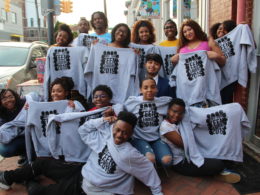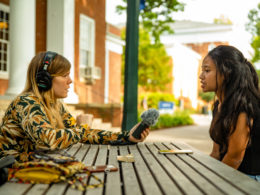Barbara Couto Sipe wasn’t looking for a change. By any measure, she and her team at NextUp RVA were doing transformational work, helping enact programs that led to on-time graduation rates within the City of Richmond’s public schools. And so, when she got the call from United Way of Greater Richmond & Petersburg’s search committee, she wasn’t sure they were talking to the right person. But soon enough, her surprise edged toward intrigue, and before she knew it, she recognized in herself what the committee charged with finding a new United Way leader had seen in her all along.

Her previous years as VP of Community Impact at the Richmond United Way – not to mention time at United Way HQ in D.C. – had imprinted in her just the right experience to take on this new assignment: president and CEO of the United Way of Greater Richmond & Petersburg.
The Phil sat down with Barbara to talk to her about her background and her vision for the organization. She begins work today – June 16.
Congrats on the new position. Excited?
It’s surreal. I can’t believe how I’m coming full circle. I’m really excited. I’m very passionate about United Way, and I hear so much from people in the community about what they want of their United Way, what they need of their United Way. So, I’m eager to make it happen for individuals, families and organizations in our region.
This wasn’t a position you were actively seeking. What was your reaction when you were approached about the idea of leading United Way?
I thought, “really, are you sure?” To be fair, that reaction was really about wanting to be sure that my vision for United Way was aligned with the board’s. My focus has always been on the “impact model,” and so when I met with the search committee, I shared my view of an impact United Way. And during the meeting, heads were nodding as if to say, “yes, that’s what we’re looking for.” I think there’s a shared vision about what we want to get done, which is also what the community needs.
Can you describe in more detail what you mean by the “impact model?”
United Way essentially has three major buckets of work or service that it provides: addressing pressing needs, increasing access to community programs and opportunities, and investing in systemic change and policy.
To address our community’s pressing needs – we must understand what issues are affecting people today. Affordable housing, for example, is a major issue across our region in both rural and urban communities alike, and it’s nearing a crisis level. COVID brought out or exacerbated other needs. People were experiencing financial insecurity due to loss of a job or income. For our youth, there was a greater need for technology as students required internet access and laptops to be able to continue learning. I really believe United Way must stay in tune with and sometimes even ahead of these needs that are affecting people. We need to lead the call-to-action across the community to mobilize governments, individuals, the charitable sector, the faith-based sector, volunteers and the business community to help those in need.
The other really important part of United Way’s impact is its effort to increase access to programs and opportunities for people across the 11 localities that we support. And that’s where our annual community investments come in. Each year, United Way raises money and then allocates this funding to local nonprofit programs. That is to ensure that there are services being provided for the people who need them and that those organizations are using these funds to create lasting impact in the community.
United Way is also invested in creating impact through systems change and policy. That includes building coalitions, digging deep and building collaborations to share resources. At the same time, we need to be scaling solutions that are proven to work while breaking down barriers to access. And then there needs to be a willingness to address the policies that are hindering people’s ability to meet their basic needs and to thrive. Those are the three pieces of United Way’s impact.
There’s a foundational part of what United Way does that speaks to all that, and that’s your capacity for research and assessment. That can often get overlooked, but you are essentially in a singular position to establish those priorities. Everyone’s out there raising money. If you want to give money that focuses on this community’s greatest needs, really what you want to do is support United Way. Am I right in thinking that?
Yes, absolutely. Especially if you want to be a part of collective impact – where your dollars can be paired with other dollars and deployed in a strategic way to address pressing needs and solutions. And you can be assured that someone is there watching the shop to make sure those programs are the best of the best and are having a real impact on people’s lives. Because United Way is looking across the whole region and the whole human continuum, from supporting children at birth to connecting older adults, we’re able to holistically address the ecosystem of need. I think people look to United Way to have the subject-matter expertise in each of the focus areas, to convene people and groups around those issues, and to create action to do more. It’s a true synergy.
What do you think the biggest misperceptions are about United Way as you return to the flock so to speak?
I think there are two big misperceptions. The first is that a person must have a lot of money to make an impact. No matter how much someone chooses to donate, they will be helping to improve the lives of families and older adults across this region. There is no gift of time, talent or treasure too small to help someone else. Additionally, one of the many values of United Way is that one person’s investment is joined by many others to support a network of programs and partnerships that produces outcomes for people right here.
The other misperception is that United Way is a middleman, and one should just donate directly to a specific agency. I think it is important to support causes and agencies important to you whether that is directly or through designating your donation through United Way. What I want to clarify is that United Way is a nonprofit agency that assures the availability of an entire network of human services. For example, a homeless family needs food, clothing and shelter. If you give to a specific agency, you can make this happen. However, most families will also need job training, childcare, school support, counseling and transportation. No one agency can meet all the needs of homeless families across this region. An investment in United Way makes sure all these services are available, from the temporary bed to the long-term solutions for economic mobility and security.
How would you assess United Way’s place in the community right now?
As I’ve talked with folks and run across my peers in the nonprofit community, people share with me that they value United Way’s convening power, its data and research, its fundraising and grant-making. They tell me we need United Way. They need United Way to speak up about the issues that communities and organizations are working so hard to address.
I also see across the region right now a lot of cross-sector energy to build a region of inclusive mobility. How are we being inclusive and intentional in creating opportunities for economic growth AND for all people, especially our marginalized communities and minority groups that have faced barriers for generations? How are we intentionally making sure that we are removing those barriers so that everyone has the opportunity to thrive? United Way will be a partner in making this a reality for our communities. I think United Way brings a big voice that can engage a broad audience and facilitate hard conversations about what matters.
In the next installment, Barbara talks more about United Way’s priorities, biggest challenges and what she has planned for her first days on the job.










